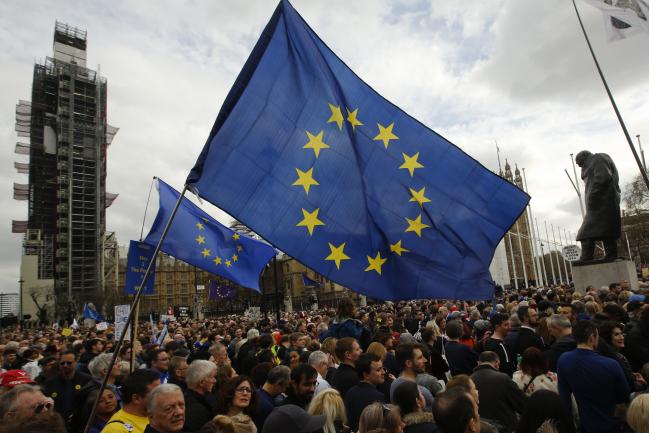(Bloomberg) -- Follow @Brexit, sign up to our Brexit Bulletin, and tell us your Brexit story.
Having finally seized control of the Brexit process, at least for a day, British members of Parliament are setting out how they think things should move forward. They’ll vote on options -- including keeping close ties to the bloc and a second referendum -- from 7 p.m. London time, using pens and paper ballots.
MPs will be able to vote for every option that they support, with the object of finding a solution that could get a majority. The result isn’t binding on the government -- but Parliament could try to make it so, in subsequent moves.
There are two types of motion, those that focus on outcomes -- what sort of relationship the U.K. should have with the European Union -- and those that deal with process -- the means of getting to that outcome.
It will be up to Speaker John Bercow to decide which are voted on. Here’s a summary of the motions, in the order listed by Parliament, including their identifiers in brackets :
Condemns Tonight’s Votes (A)
Tory Brexiteer Bill Cash’s motion criticizes the so-called indicative votes process and seeks to ban MPs from taking control of parliamentary business unless they secure a two-thirds majority.
No-Deal Brexit (B)
Proposes leaving the EU on April 12 without any kind of deal. This has been put forward by Conservative John Baron.
Rewrite the Backstop (C)
Another proposal from John Baron, for the U.K. to leave the EU on May 22 but having secured an amendment to the Withdrawal Agreement that give the U.K. a unilateral right to exit the so-called Irish backstop. This has been repeatedly rejected by the bloc.
Common Market 2.0/Norway Plus (D)
The U.K. stays in the European Economic Area and rejoins the European Free Trade Association, giving it access to the EU single market. That’s Norway’s relationship. But this adds a “comprehensive customs arrangement” to it -- hence the “Norway Plus” moniker. It’s backed by Labour’s Stephen Kinnock and Lucy Powell, and Tories Nick Boles and Robert Halfon.
Respect Brexit Vote (E)
Conservative Will Quince leads pro-Brexit motion calling on MPs to respect the result of the 2016 referendum and seeking to prevent any revocation of Article 50 to cancel the divorce.
Customs Union (F)
A motion, from Labour’s Gareth Snell, that simply instructs the government to seek a post-Brexit customs union with the EU.
Revoke Article 50 (G)
Scottish National Party member of Parliament Angus MacNeil calls on the government to revoke Article 50 if no withdrawal agreement has been agreed four days before the deadline.
Norway Option (H)
Similar to motion (D) but without the customs union. The U.K. stays in the European Economic Area and rejoins the European Free Trade Association, giving it single-market access. Proposed by Tory MP George Eustice.
Consult the Devolved Parliaments (I)
A process motion from the Scottish National Party’s Ian Blackford that says the U.K. shouldn’t leave the EU without the agreement of the Scottish Parliament and the Welsh Assembly.
Customs Union (J)
Tory grandee Ken Clarke wants the U.K. to leave the EU having secured a permanent customs union with the bloc at a minimum.
Labour’s Brexit Plan (K)
The official Labour proposal, to back the Withdrawal Agreement that Prime Minister Theresa May has negotiated, in return for her seeking a customs union with the EU, a close alignment with the single market, and a close relationship to other institutions.
No-Deal Emergency Brake (L)
A process amendment, this would require a confirmatory vote in Parliament if the U.K. got to within two days of a no-deal Brexit. Proposed by the Scottish National Party’s Joanna Cherry, it’s also backed by Tory Dominic Grieve and Liberal Democratic Party leader Vince Cable.
Second Referendum (M)
A process motion that says Parliament shouldn’t ratify or implement any withdrawal agreement until it has been approved in a referendum. In the name of Labour’s Margaret Beckett, as well as Peter Kyle and Phil Wilson.
Malthouse Plan A (N)
The idea that briefly looked as though it could save May’s deal is back. It’s the prime minister’s agreement, without the Irish backstop section that Tory MPs hate but that the EU insists on. May has asked MPs not to vote for things the EU will refuse, but she has previously voted for this, so it’s not clear if that would be included.
Malthouse Plan B (O)
This is the other part of the so-called Malthouse compromise, which says that if Plan A (see above) doesn’t work, the U.K. should seek a “standstill” agreement with the EU while a broader trade deal is negotiated. Tory Brexiteer Marcus Fysh has proposed it.
Managed No Deal (P)
Another proposal from Tory MP Marcus Fysh, this seeks to manage a no-deal Brexit to mitigate disruption. The EU has repeatedly ruled out the concept of a managed no-deal, and has called on members states not to negotiate mini deals with the U.K.
(Updates with full list of amendments throughout.)
